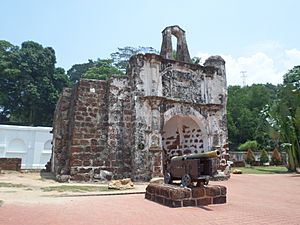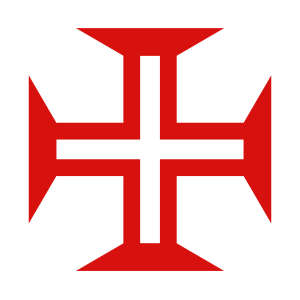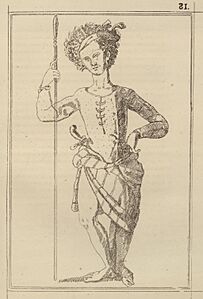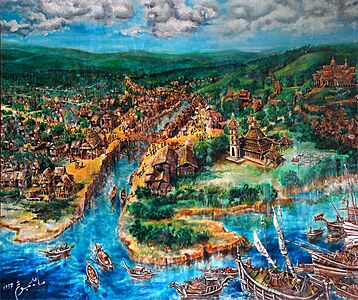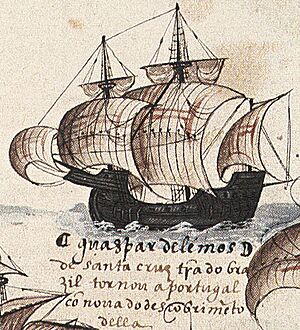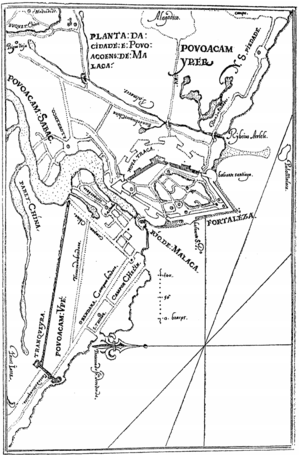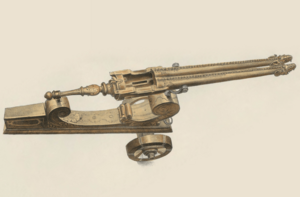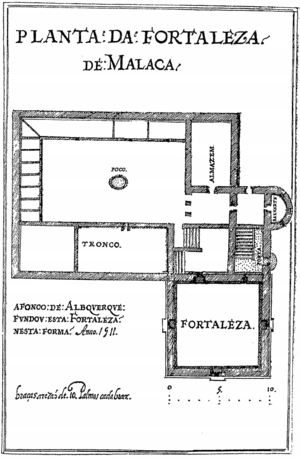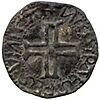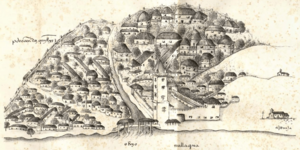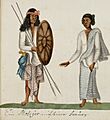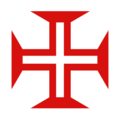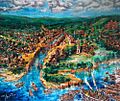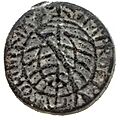Capture of Malacca (1511) facts for kids
Quick facts for kids Capture of Malacca |
|||||||||
|---|---|---|---|---|---|---|---|---|---|
| Part of Malay–Portuguese conflicts | |||||||||
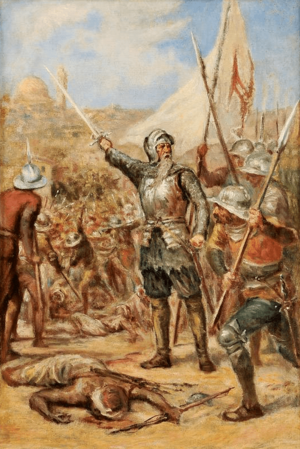 "The Conquest of Malacca, 1511" by Ernesto Condeixa (1858–1933). |
|||||||||
|
|||||||||
| Belligerents | |||||||||
| Malacca Sultanate | |||||||||
| Commanders and leaders | |||||||||
| Mahmud Shah | |||||||||
| Strength | |||||||||
|
1,500 Portuguese soldiers 3 caravels 2 galleys |
20,000 men Unknown number of lancaran 20 penjajap |
||||||||
| Casualties and losses | |||||||||
| 28 dead | Unknown | ||||||||
The Capture of Malacca in 1511 happened when Afonso de Albuquerque, the governor of Portuguese India, took control of the city of Malacca. This event was a big deal in history. It was the farthest a European power had conquered at that time.
Malacca was a very important port city. It controlled the narrow Strait of Malacca. This strait was like a highway for all sea trade between China and India. Portugal's King Manuel I of Portugal wanted to control this trade route. Albuquerque also wanted to build strong Portuguese bases in places like Hormuz, Goa, and Malacca. This would help Portugal control trade and stop Muslim ships in the Indian Ocean.
Albuquerque's journey started from Cochin in April 1511. The strong monsoon winds meant they couldn't turn back. If they failed, there would be no help from India. This made the mission very risky.
Contents
Why Malacca Was Important
The Portuguese first heard about Malacca after Vasco da Gama found a direct sea route to India. They learned it was a city where valuable goods like cloves, nutmeg, porcelain, and silks were sold. King Manuel wanted to connect with Malacca. He thought it was important for Portugal's trade plans.
In 1505, Dom Francisco de Almeida was sent as the first Viceroy of Portuguese India. One of his jobs was to find Malacca's exact location. However, he couldn't send many resources. He sent two secret Portuguese messengers in 1506. But their mission failed when they were found out.
The City of Malacca
Malacca was founded in the early 1400s. All trade between China and India passed through it. Because of its great location, many different merchants lived there. These included Arabs, Persians, Chinese, and people from India and Java.
According to Tomé Pires, a Portuguese who lived there, people spoke 84 different languages in Malacca. The city was built on swampy land. It was surrounded by thick tropical forest. Malacca had to import almost everything it needed, especially rice. Rice came from Java, Siam, and Pegu.
Malacca was mainly a trading city. It did not have much farmland. Most of its 10,000 buildings were made of straw. Only about 500 were made of adobe (a type of brick). The city also lacked strong defenses. It only had temporary bamboo fences. Rich merchants stored their goods in strong stone warehouses.
First Meeting with the Portuguese
King Manuel was not happy with Almeida's slow progress. So, in April 1508, he sent a fleet of four ships directly to Malacca. This fleet was led by Diogo Lopes de Sequeira. His orders were to make friends and open a trading post peacefully. He was told not to start any fights.
Sequeira arrived in Malacca in September 1509. He quickly met with Chinese merchants. They helped him arrange a meeting with Sultan Mahmud. The Sultan agreed to let the Portuguese set up a trading post. He even gave them an empty building.
However, powerful Muslim merchants from Gujarat and Java were worried. They convinced Sultan Mahmud to betray the Portuguese. Sequeira was very trusting. He ignored warnings that the Malaccans were planning an attack.
While Sequeira was playing chess on his ship, the Malaccan fleet attacked. The Portuguese fought back. But there were too many Malaccan ships. Sequeira decided to sail back to India. He left behind 20 Portuguese who had been in the trading post. Before leaving, he sent a harsh message to the Sultan.
Getting Ready for the Conquest
When Sequeira returned to India, he found that Afonso de Albuquerque was now the Governor. Albuquerque had received messages from the Portuguese prisoners in Malacca. One of them, Rui de Araújo, described their terrible captivity. He also explained Malacca's military strength and its importance.
Albuquerque then took charge of the expedition to Malacca. In April, he left Cochin with 1,000 men and 18 ships. Some sources say there were 1,500 Portuguese soldiers and 800 Chinese and Indian helpers. The Portuguese fleet had 400 guns.
Journey Across the Indian Ocean
On the way to Southeast Asia, the Portuguese fleet lost two ships. In Sumatra, they rescued nine Portuguese prisoners. These prisoners had escaped to the Kingdom of Pedir. They told Albuquerque that Malacca was divided inside. They also said the Sultan's chief minister had been killed.
The Portuguese also captured a large Javanese ship. It was bigger than their own flagship. The Javanese ship fought back. But after two days of constant firing, it surrendered.
Malacca's Preparations
The Malacca Sultanate controlled the entire Malay Peninsula and parts of Sumatra. Many areas sent troops to help the Sultan. He also hired thousands of Javanese and 3,000 Turkic and Iranian fighters. The Sultan gathered 8,000 gunpowder weapons, including cannons. Chinese merchants told the Portuguese that the Sultan had 20,000 fighting men.
Even though Malacca had many guns, they were mostly bought from Java and Gujarat. The Javanese and Gujaratis were the ones who knew how to use them. Before the Portuguese arrived, the Malays did not use firearms much. Old Malay stories say that in 1509, they didn't understand "why bullets killed."
Historians say that there is no proof that guns or gunpowder were made in Malay states. Also, there is no evidence that the Malacca Sultanate used guns in battle before the Portuguese attack. The Malays mostly used small cannons.
The people of the Malay Peninsula did not use big ships for ocean travel. They used smaller boats like lancaran and banting for coastal trips. Malacca did not have a large shipbuilding industry.
The real number of Malaccan fighters was probably not more than 4,000. The rest were slaves forced to fight. Their main weapons were lances, bows, and blowpipes. Very few wore armor. Most of their cannons were small. They were not as powerful as the Portuguese cannons. Malacca did not have a professional army. Their "army" was just common people gathered for war.
Malacca was a typical Malay city built along a river. It had no strong walls or permanent forts. They used temporary wooden or bamboo fences for defense. Only the royal palace area was usually fortified. Most buildings were made of wood, mats, and bamboo. The only stone buildings were the mosque and tombs.
A foreign observer noted that the Malays believed their bodies would serve as walls. This shows they didn't rely on strong fortifications. Later, a cartographer named Manuel Godinho de Erédia pointed out the weaknesses of the Malay troops. They lacked organized fighting tactics, armor, and strong forts. Their artillery was light.
The Malaccans had only learned about firearms after 1509. So, they relied on Gujaratis to help them build defenses. A Gujarati captain even promised 600 fighters and 20 cannons. Iranians, who were important traders, also helped defend Malacca.
Portuguese Conquest
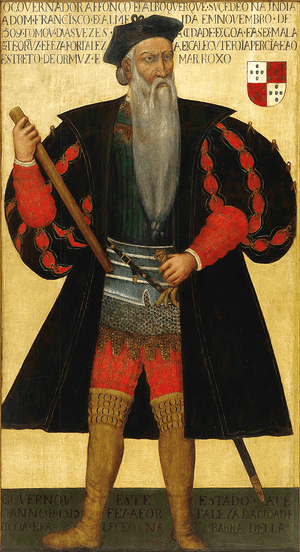
The Portuguese fleet arrived at Malacca by July 1. They fired their guns, causing a stir in the harbor. Albuquerque demanded the release of the prisoners without payment. But Sultan Mahmud Shah gave vague answers. He tried to buy time to fortify the city.
Albuquerque kept getting messages from Rui de Araújo, the prisoner. Araújo told him about the Sultan's forces. He said the Sultan had 20,000 men, including Turkish and Persian archers, many cannons, and 20 war elephants. But he also said the cannons were not very good and lacked enough gunners. Albuquerque later reported that only 4,000 of these men were ready for battle.
The Sultan was not very scared of the small Portuguese force. Albuquerque wrote that the Sultan had correctly guessed the number of Portuguese soldiers. So, the Sultan stayed in the city, organizing its defense.
By mid-July, the Portuguese started firing cannons at the city. The Sultan quickly released the prisoners. Albuquerque then demanded a huge payment and permission to build a fortress. The Sultan refused. Albuquerque then told his captains that they would attack on July 25.
During the talks, representatives from Hindu and Chinese merchant communities visited Albuquerque. They offered their support. The Chinese offered barges to help land troops. Albuquerque said he didn't want them to suffer if the attack failed. He even invited them to watch the battle safely from a ship. This made a very good impression on the Chinese.
First Attack
Albuquerque split his forces into two groups. The landing started at 2 AM. The Portuguese ships fired at enemy positions on shore. The infantry rowed their boats to the beaches on both sides of the city's bridge. They faced cannon fire from Malaccan defenses, but it wasn't very effective.
Albuquerque landed his men west of the bridge. Another group landed on the east side, where the Sultan's palace and a mosque were. Once ashore, the Portuguese used their shields to walk over traps and gunpowder mines.
Wearing steel helmets and armor, the Portuguese charged the Malaccan defenses. They broke through resistance quickly. Albuquerque's group pushed defenders back to the main street and moved towards the bridge. There, they faced strong resistance.
On the east side, the Portuguese faced a counter-attack by the royal war elephants. The Sultan, his son, and his son-in-law led these elephants. The Portuguese soldiers, though briefly shaken, attacked the royal elephant with their long pikes. This caused the elephant to panic and run away, scattering the other elephants and the troops. The Sultan fell from his elephant and was hurt, but he escaped.
By midday, the two Portuguese groups met at the bridge. They surrounded the last defenders, who jumped into the river. Portuguese boat crews caught them. With the bridge secure, the Portuguese put up canvas sheets for shade. The attack was stopped because they were running low on supplies. Albuquerque ordered his troops to go back to their ships. On the way, they set the royal palace and mosque on fire.
To stop the Malaccans from taking back the bridge, the Portuguese captured a ship the next day. They armed it with cannons and long pikes. They towed it towards the bridge. It got stuck at the river mouth and came under heavy fire.
Second Attack
On August 8, Albuquerque held a meeting. He said they needed to take the city to stop the flow of spices to Cairo and Mecca. For this attack, Albuquerque landed all his forces on the western side of Malacca. They were supported by a small ship, a galley, and armed landing boats. As the armed ship moved towards the bridge, drawing fire, the landing began. The fleet also fired at the city.
Once ashore, the Portuguese quickly broke through Malaccan defenses. They recaptured the bridge, which was now empty of defenders. On both sides of the bridge, the Portuguese set up barricades with dirt barrels and placed cannons. From the east side, a group attacked the mosque. After a long fight, they defeated the defenders.
With the bridge fortified and supplied, Albuquerque sent groups to clear the streets. They removed Malaccan guns from rooftops and fought anyone who resisted. Many civilians were killed.
By August 24, the Sultan's resistance was weakening. Albuquerque decided to take full control of the city. He led 400 men through the streets, with drums and trumpets playing. They cleared out any remaining groups of fighters. Old stories say the Malaccans were scared of the Portuguese's long pikes, which they had never seen before.
The cleanup took 8 days. The Sultan, unable to fight anymore, gathered his royal treasures and remaining forces. He retreated into the jungle.
Looting the City
Once the city was safe, Albuquerque ordered an organized looting. For three days, from morning to night, groups took turns going into the city. They could take whatever they could carry back to the beach. They were strictly forbidden from taking anything from Chinese, Hindu, and Peguan homes. These groups had supported the Portuguese. Their houses were marked with flags. The general population of Malacca was not harmed.
The amount of treasure was huge. Over 200,000 cruzados (Portuguese money) went to the Crown. They also captured 3,000 bronze and iron cannons and many slaves. The cannons found were of different types, including small swivel guns and medium-sized cannons. The Malaccans also had a large cannon from the king of Calicut.
Albuquerque praised the Malaccan gunmakers, comparing them to those in Germany. He said their gun carriages were better than any other, including Portugal's. A Portuguese writer said that the gunmakers in Malacca were Javanese. The Javanese also made their cannons in Malacca. The Portuguese also captured 3,000 of the 5,000 muskets that came from Java.
According to one account, regular soldiers received over 4,000 cruzados each. Captains received up to 30,000. At that time, 1,000 cruzados was about the same as a count's yearly income in Portugal. Albuquerque found a jewel-covered stool, four golden lions, and a golden bracelet. He believed two-thirds of the city's wealth remained.
What Happened Next
28 Portuguese soldiers were killed during the attack, and many more were wounded. Even though Sultan Mahmud Shah had many cannons and firearms, they were mostly not effective. Most Portuguese injuries were from poisoned arrows.
After the battle, the Sultan moved a few kilometers south of Malacca. He set up camp by the Muar River, waiting for the Portuguese to leave.
Building a Fortress
Albuquerque did not plan to just loot the city. He wanted to keep it permanently. He ordered a fortress to be built near the shore. It became known as A Famosa (The Famous One). It had a very tall keep, over 18 meters (60 feet) high. Stone for the fortress was brought by ships because there wasn't enough in the city. The fortress had 500 men as a garrison. They also used stones from a tomb and the city's mosque to build it.
New Rules and Friends
Albuquerque knew that keeping Malacca would need local support. He promised the people that they could continue their normal lives. Nina Chatu, a Hindu merchant, became the new chief minister of Malacca. The Javanese, Luzonian, and Malay communities also got their own leaders. One Javanese leader, Utimuta Raja, was later executed for plotting with the exiled Sultan. This was the first time the Portuguese used their own laws in Malacca.
New money was made with Nina Chatu's help. A parade was held where new coins were thrown to the people from elephants. Two messengers announced the new laws, one in Portuguese and one in Malay. Portuguese troops marched behind them, playing music. This surprised the locals.
Albuquerque sent messengers to Pegu and Ayutthaya. He wanted to find new friends and get food supplies like rice. The Javanese were now enemies. The King of Ayutthaya, who disliked Mahmud Shah, strongly supported the Portuguese. The Kingdom of Pegu also supported them. By 1513, ships from Pegu came to trade in Malacca.
While in Malacca, Albuquerque met with leaders and messengers from many kingdoms in Maritime Southeast Asia. They brought gifts for the King of Portugal.
The Portuguese found a large map from a Javanese sailor. Albuquerque said it showed:
- The Cape of Good Hope
- Portugal and Brazil
- The Red Sea and Persian Sea
- The Spice Islands
- Chinese and Gores (Ryukyuan people) trade routes
- How kingdoms bordered each other
This map helped the Portuguese find the famous "Spice Islands". In November, Albuquerque sent an expedition of three ships and 120 men to reach them. This group was led by António de Abreu. He was the first European to sail into the Pacific Ocean.
When Albuquerque left Malacca in January 1512, the people were sad to see him go. His flagship, the Flor do Mar, sank in a storm near Sumatra. He lost important papers and gifts for the King of Portugal. But a large ruby, a fancy sword, and a golden cup from the King of Ayutthaya were saved.
In 1513, Jorge Álvares sailed from Malacca to Canton, making contact with China.
Defending Malacca and Sultan Mahmud Shah's Fate
Soon after Albuquerque left, Sultan Mahmud Shah's forces attacked Malacca. But the Portuguese had over 500 local people helping them fight back. In May, the Portuguese and over 2,000 local allies forced the Sultan out of his camp. Mahmud Shah then went to the Pahang Sultanate. He barely escaped an attempt to kill him there.
After that, he moved to Bintan, an island kingdom. He took over Bintan to continue fighting the Portuguese in Malacca. He attacked the city, its trade, and tried to ruin their relations with China. But in 1526, the Portuguese attacked Bintan. They gave it back to its old ruler and made it a friendly kingdom. Mahmud Shah then went to Kampar, Sumatra, and led a government from there until he died in 1527. His son, Alauddin, later founded the Sultanate of Johor. He had more peaceful relations with the Portuguese.
Images for kids
-
16th century Portuguese naval banner bearing the cross of the Order of Christ.
-
Afonso de Albuquerque, 2nd Governor of Portuguese India.
-
A cannon from East Indies (precisely Java), ca. 1522.


